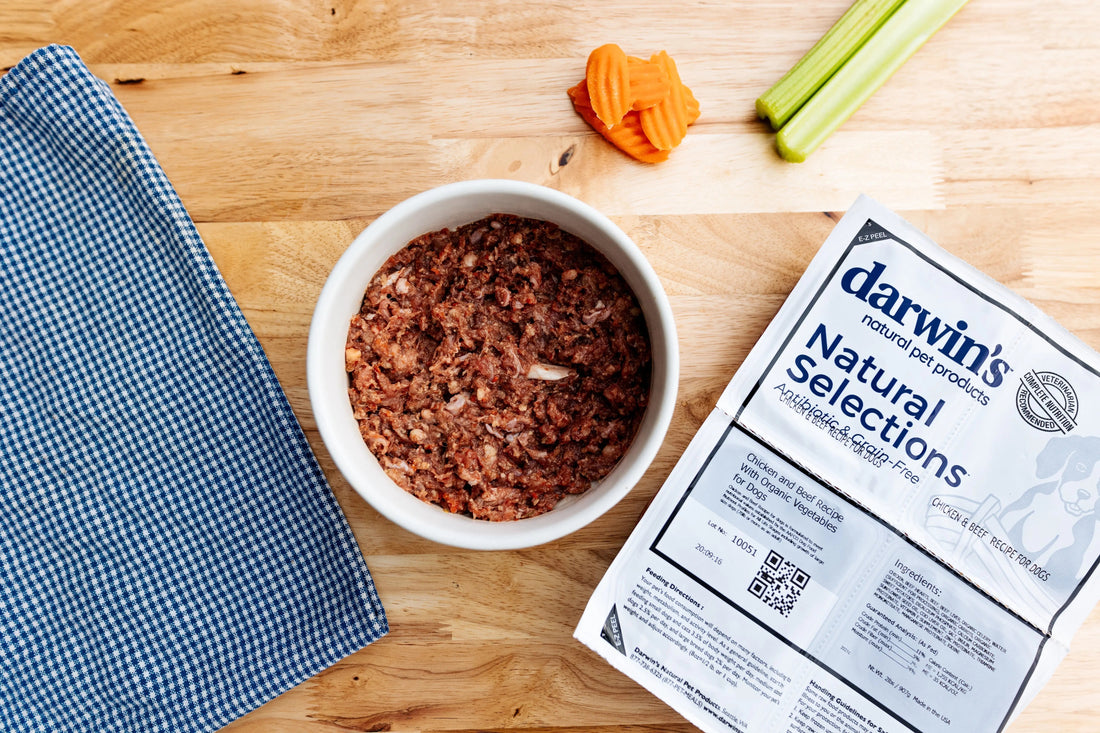
How Much Protein in Dog Food is Ideal?
Written by Darwin's
If you're reading this, it's safe to assume you have one of those furry companions who brighten your day. Our dogs are more than just pets; they're family. And, as responsible dog owners, we want to provide them with the best of everything, especially when it comes to their food.
You might be pondering questions like, "How much protein in dog food is too much?" or "Is high protein good for dogs?" This guide will dive into these burning questions.
Understanding Protein in Dog Food
Before we go any further, let's get the lowdown on what protein really is and why it's a hot topic in the world of pet nutrition.
Protein: The Body's Building Blocks
Proteins are like the building blocks of life for dogs (and for us, too). They are made up of amino acids, which are the essential elements that keep your dog's body ticking. These amino acids help build and repair tissues, promote healthy skin and coat, and maintain strong muscles.
Sources of Protein in Dog Food
Now, where do we find this precious protein in different types of dog food? Look no further than meat, poultry, and fish. These animal proteins are packed with the good stuff your furry friend needs to thrive.
Ideal Protein Levels
When it comes to the right amount of protein in your dog's diet, it's not a one-size-fits-all scenario. Dogs have different needs based on their age, size, and activity level. Let's break it down:
Puppies
Growing puppies need more protein to fuel their developing bodies. Aim for a puppy food with a protein level of about 22-32%.
Adult Dogs
For the average adult dog, a protein content of around 18-25% in their diet does the trick. This keeps them in tip-top shape without overloading their system.
Senior Dogs
As our furry friends gracefully age, their protein requirements tend to decrease. Senior dogs usually do well with a diet containing about 20-25% protein, which supports their aging joints and muscles.
High Protein Diets: Pros and Cons
Now, here's where things get a bit meatier – the high-protein diet debate. There are pros and cons to consider when thinking about upping the protein content in your dog's diet.
The Pros of High Protein
- Active Dogs Thrive: If you have a sporty or active dog, a high-protein diet can provide the energy they need to keep chasing that ball.
- Muscle Marvel: For dogs building muscle, such as working dogs or those in training, protein is essential for maintaining their strength.
- Healthy Skin and Shiny Coat: Protein helps in the production of keratin, the protein that makes your dog's coat smooth and glossy.
The Cons of High Protein
- Kidney Concerns: Excessive protein can strain a dog's kidneys, particularly if they have underlying kidney issues.
- Packing on Pounds: High-protein diets may lead to weight gain if not properly managed. Balance is key.
- Gastrointestinal Distress: Some dogs might experience digestive issues with a high-protein diet, leading to upset tummies.
How Protein Works with Other Nutrients
Protein is essential, but it doesn’t work alone—your dog’s diet needs the right balance of other nutrients to support overall health.
- Fats: Provide long-lasting energy and support skin and coat health.
- Carbohydrates: While not essential, they can offer quick energy, especially for active dogs.
- Vitamins & Minerals: Support immune function, digestion, and bone health.
Choosing the Right Dog Food
So, how do you choose the best dog food with the right protein content for your beloved pup? It's all about reading the labels and understanding the information presented.
Decoding Dog Food Labels
Take a look at the dog food label. You'll find the protein content listed as "crude protein." Remember, this includes all sources of protein, not just meat. Aim for a brand that lists a specific meat source at the top of the ingredient list.
Tailored to Your Pup's Needs
Consider your dog's unique requirements when choosing the right protein for your dog. Is your German Shepherd a budding athlete? Opt for a high-protein blend. Does your senior Beagle prefer a leisurely stroll over a run? A balanced protein level will keep them in tip-top shape.
The Magic of Blended Proteins
Blended proteins in dog food offer a mix of sources, which can provide a well-rounded amino acid profile. Look for brands that incorporate both animal and plant proteins to give your dog the best of both worlds.
Raw Dog Food
Many dog owners are turning to raw dog food diets, believing they closely mimic a dog's ancestral diet. These diets typically consist of raw meat, bones, and sometimes vegetables. While some dogs thrive on them, it's essential to consult with your vet to determine if raw or cooked dog food is best for your dog’s nutritional needs.
Wet vs. Dry Dog Food
The eternal debate: wet vs. dry dog food? Wet food often boasts higher moisture content and can be more appealing to picky eaters or dogs with dental issues. Dry dog food, on the other hand, is convenient, cost-effective, and can help keep your dog's teeth clean. The key is finding the right balance that suits your dog's preferences and dietary requirements.
Raw vs. Cooked Dog Food
So, should you get raw vs cooked dog food? Different cooking methods can impact the nutritional value of proteins.
- Raw diets preserve natural enzymes and amino acids but require careful handling.
- Kibble is cooked at high temperatures, which may reduce some protein quality.
- Freeze-dried and air-dried dog foods retain most of their protein integrity.
Understanding how food processing affects protein can help you choose the best option for your dog’s needs.
Common Myths About Protein in Dog Food
There’s a lot of misinformation about protein in dog diets. Let’s clear up some common myths:
- “More Protein Always Means Better Health.” Not necessarily—excess protein that isn’t used gets stored as fat or excreted.
- “High-Protein Diets Damage Healthy Kidneys.” Unless a dog has pre-existing kidney disease, a high-protein diet won’t cause kidney damage.
- “Dogs Need Carbs Instead of Protein for Energy.” Dogs thrive on protein and fat for energy; carbohydrates are not essential.
- “All Protein Sources Are Equal.” Animal proteins are more bioavailable than plant-based proteins, making them the superior choice.
Understanding these myths can help you make informed choices for your dog’s diet.
FAQs About Protein in Dog Food
Can I Overfeed My Dog with Protein?
Absolutely, yes! Just like too much of anything isn't good for us, the same goes for our dogs. Overfeeding your dog with excess protein can lead to health issues, so always stick to their recommended daily intake. Understanding how much to feed your dog is vital in maintaining their health and preventing any nutritional imbalances caused by overfeeding.
What Are the Signs of Protein Deficiency in Dogs?
Low energy, muscle loss, dull coat, and weight loss can be signs of protein deficiency. If you notice any of these symptoms, it's time to consult your vet and make dietary adjustments.
Exploring the World of Dog Food
Protein in your dog's diet is vital, and finding the right balance is key to their overall well-being. Whether you have a growing puppy, an active German Shepherd, or a wise senior dog, understanding their protein needs is a surefire way to keep their tails wagging with delight.
As you explore the world of dog food, remember the importance of reading labels, balancing protein levels, and customizing your dog's diet to meet their specific requirements. Including options like freeze-dried liver dog treats can provide additional protein and nutrients, helping keep your dog healthy and energized. A healthy, well-fed dog is a happy companion, ready to share a lifetime of memories with you.
And if you're in search of top-notch dog food that aligns perfectly with your dog's nutritional needs, consider exploring Darwin's natural dog food selection. Their commitment to providing high-quality, balanced, and delicious meals ensures that your furry family member receives the best care nature can offer.


